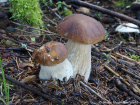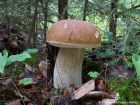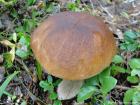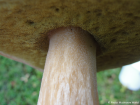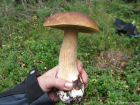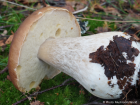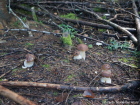Cap convex in shape when young and flattens with age, colour is quite variable from light brown to reddish-brown. Flesh white, unchanged when cut or bruised. The pore layer is quite hard when young and white changing to yellowish then to pea soup green to greenish-brown becoming fairly soft at maturity. Tubes are white at first, slowly becoming greyish-yellow to olive-brown. Stem often very thick and club-shaped and usually finely reticulated meaning it has a net-shaped raised pattern on the surface. The reticulation is most pronounced near the top. The colour can vary from whitish cream to reddish-brown. It can become cylindrical at maturity. Ring absent. Interior solid. Spore print olive-brown.
Microscopic Features: The spores are subfusiform (narrow and tapering at both ends), smooth, and measure 14-17 x 5-7μm.
Similar species include Boletus pinophilus and Tylopilus felleus which is similar when young but tastes bitter.
Boletus edulis on the First Nature Web site.
Boletus edulis on the MushroomExpert.Com Web site.
Boletus cf. edulis on the MushroomExpert.Com Web site.
Many mushrooms are poisonous, and some can be lethally toxic. Distinguishing between edible and poisonous mushrooms can be very challenging. Therefore, we strongly advise against consuming wild mushrooms. This website does not contain any information about the edibility or toxicity of mushrooms.
Although efforts have been made to ensure accuracy on this website, the information may contain errors and omissions. Therefore, all content provided is for educational and informational purposes only and should not be relied upon or used as a basis for consuming any plants or mushrooms.
External links are provided for reference only. We do not endorse or take responsibility for the content, advice, or products found on these sites or in any advertisements shown on this website.
